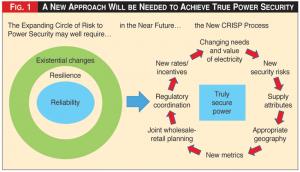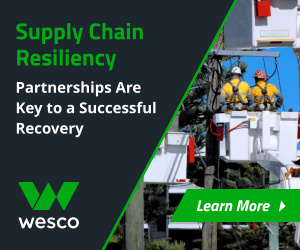True Power Security through CRISP
Elliot Roseman is a strategic energy advisor with decades of power sector experience, specializing in helping executives make decisions relating to resilience, sustainability, technologies and markets in times of significant change. He has worked extensively with utilities, IPPs, trade associations and regulators, in the US and internationally.
Business as usual will not do. Recent major storms that cut power supplies for weeks or months, such as Hurricanes Harvey, Irma and Maria; significant power outages such as the one at the Atlanta airport that stranded thousands of travelers; and the Department of Energy’s proposed Grid Rule have rekindled the debate about what constitutes a reliable and resilient supply of power, and what it will cost. This is a propitious time for such a debate.

“Reliability” is generally defined as the ability to keep the lights on under normal system operation. “Resilience” is regarded as the ability to recover from unanticipated or extreme events, whether due to natural disasters or caused by humans.
While both are critical and require careful attention, these two concepts are insufficient to cover the future significant risks to power supplies. In fact, the paradigm shifts taking place in power markets today are creating a much broader need, one that requires new metrics, policy guidance and a clear, integrated process to ensure the secure power system that customers need for tomorrow’s economy, and on which daily life depends.
What shifts are giving rise to these new needs? First, the shift taking place to distributed resources such as rooftop solar, EVs/local storage and demand response constitutes a risk to the continued secure local supply of power, such as the hosting capacity of lines, feeders and substations.
Second, the rapid price reductions and growth of both intermittent and firm sources of power such as solar, wind and storage on the wholesale grid, along with the low price of natural gas, are pushing several traditional baseload sources into lower utilization and early retirement. That is causing greater ramping — the so-called duck curve — and peak time issues.
 Figure 1 - A New Approach Will be Needed to Achieve True Power Security
Figure 1 - A New Approach Will be Needed to Achieve True Power Security
The coal-fired St. Johns River Park, San Juan Generating Station, J.M. Stuart, and Navajo Generating Station all announced early retirements in the first half of 2017, even though all are MATS-compliant, and some are relatively young power plants. Add nuclear plants such as Indian Point, Three Mile Island and Diablo Canyon to this list, and it’s clear that we are facing a major transition in our baseload generation mix.
Third, our future power supply must factor in the policy requirements in many states and cities to reduce emissions and mitigate climate impacts. On top of these initiatives, many customers share such concerns, and some are signing their own renewable or system power supply contracts, making market-based deals, or forming new geographic aggregations (for example, Community Choice Aggregation in California) to meet them.
These factors are directly related. The retirement of nuclear plants makes it harder to achieve emissions objectives, as it removes the largest source of non-emitting capacity from the generation mix. The proliferation of distributed resources lowers or eliminates growth in kilowatt-hour sales, and puts greater pressure on traditional sources to compete for the end-use customer’s needs.
These three factors – more distributed resources, rapid price reductions, and increasing policy and market drivers – are neither “normal”, invoking reliability, nor “unanticipated”, invoking resilience. Business as usual will not maintain secure power supplies.
Utilities, regulators, regional entities, and power providers must still prepare and invest properly to accommodate these sea-changes to assure a future near-uninterrupted supply of power. If we maintain the status quo, the risk to secure power supplies will rise.
Moreover, these changes are taking place at the same time as the value of electric power to customers is rapidly rising, leading to less tolerance for insecure supplies. We continue to own more devices, conduct more cyber-transactions that require more data centers, convert our transportation fleet to electricity, and convert commercial and industrial processes to electricity.
The loss of power today and in coming decades would have profound economic costs and cause major societal disruptions. Lack of power puts us quickly back into the nineteenth century.
Note what happened recently in Puerto Rico, where the economy has been decimated. Nearly two-thirds of the power supply had not been restored by year-end 2017. In 2003, analysts estimated the economic cost of the northeast U.S. blackout at ten billion dollars, and that event just lasted eighteen hours. Almost fifteen years later, the impact would be multiples higher and could last a lot longer.
Without power, our factories go silent; our homes become unbearable to live in; and our retail and online economy grinds to a halt. Our gas pipeline operations and clean water supplies are based on secure supplies of electricity.
Based on the share of our economy directly affected by electricity, I estimate that on average, every kilowatt-hour is worth at least two dollars and fifty cents to the U.S. GNP, and much more than that in some regions and industries. Yet, the average amount we pay nationwide is twelve cents. That’s a factor of twenty to one in terms of value over cost.
As a society, we would be willing to spend a good deal more to achieve a secure supply of power. As the risks to such supply rise, it’s worth spending more to ensure them.
Planning for a secure power supply should explicitly take the economic impact of outages, known as the value of potentially lost load (VOLL), into account. I prefer to re-phrase this in positive terms, and call it simply the value of electric power (VOEP).
Rather than just meeting today’s challenges, taking individual measures, or providing one-time fixes, what’s the best approach to prepare for the future?
What we need is a holistic commitment to power security. In particular, we need a process that covers reliability issues related to normal operations; takes all factors relating to resilience, such as security of fuel supply, transformer supply, hurricanes, and cyber-attacks, into account; and explicitly takes the fundamental paradigm changes directly into account, reflecting VOEP in the process.
This holistic process should retain traditional metrics of reliability (such as SAIDI and SAIFI) and add new measures required for resilience. For example, hardened substations; days of secure fuel supply; adequate equipment inventories. It should also include performance standards that embrace planning risks and regulatory policies at the distributed and grid levels. Those standards should reflect best practices and market opportunities.
Customers expect comprehensive power supply security. But now more than ever, delivering on this expectation is increasingly complex, and will involve multiple actors. The responsible entities would include utilities, state regulatory agencies, wholesale and retail power suppliers, RTOs and FERC at different times, in an interactive process designed to minimize power supply risks over time.
We have a limited window of time in which to get ahead of this curve before the security of power supplies deteriorates or weakens in response to these changes. In some states and localities, the window is closing or almost closed; in others, it is a couple of years away, but it will be soon, just about everywhere. And because of all the market, regulatory and technology changes taking place at the same time, we need to walk and chew gum at the same time, and do it while in mid-air!
I propose that stakeholders adopt a more comprehensive and multi-faceted approach. Achieving a future secure power supply for customers means that we either put in place a ten-point planning and implementation process, or modify existing approaches to do so.
Here are the elements of this approach. To start, we will need to understand customer needs for a secure supply of power. Some customers have greater needs for secure power, and perhaps should pay for it. We should articulate the events that could give rise to a lack of secure power, and forecast how severe the outages could be if they occur.
So-called hundred-year storms seem to occur about every five years. We must also determine how to measure our preparedness for such threats and implement needed upgrades, including an assessment of the value of lost load.
For example, VOEP analysis could justify moving substations or putting selected transmission lines underground. Specifically, the ones that serve customers with the highest value on power and the greatest economic impact, albeit at higher costs.
We also need to identify the desired attributes of all potential sources of power supply, including technical, cost and environmental attributes. We must forecast how they will perform under stressful conditions, over time, to maintain reliability, resiliency and meet policy and market needs.
It will be important to decide on and apply the standards of power security to the appropriate geography, whether to an entire RTO, state, community, or individual customer. Part of that process will involve determining what mix of supplies can best assure the supply of power, under adverse conditions, at a reasonable cost.
We need to plan holistically for both utility-scale and distributed resources, and be prepared to invest in accordance with those plans. We also need a performance measurement approach so that we can track how the new system meets customer needs and reflects market opportunities, and modify those measures over time.
It is vital for this process to play out in the regulatory arena, with coordination among economic, environmental and security regulators. Such coordination is far from trivial. As part of this process, regulators should consider and implement new rates and rate structures to reflect these priorities, including subsets of the rate classes that exist today.
What is this new process? I recommend that we call it Comprehensive Resource and Increased Security Planning (CRISP). Utilities, in particular, have the opportunity now to communicate and push forward their vision of future assured power supplies, to regulators, customers and others, taking all the CRISP factors into account, and to win approval to make this vision happen.
In states that have them, integrated resource planning (IRP and DRP) and special restructuring proceedings may provide a good vehicle for such communication and to put CRISP in place. In addition to the marquee states of California and New York, Ohio, Maryland and Minnesota are examples of states with power industry review processes in place.
The figure above displays several elements of the CRISP process, which would need to be tailored to each situation.
Does doing all this mean that the cost of power could rise from where it is today? For some, perhaps. However, in many if not most cases, the added future security of power supplies would be well worth it to customers. Every insurance policy has a premium!
Secure fuel supplies are a key part of this equation; that is the so-called inter-dependence issue. Moreover, due to the shale gas revolution, fuel and power prices in many parts of the country are a good deal lower now than they were a decade ago.
Ralph LaRossa, the CEO of PSEG Power, pointed out recently at a PJM forum that in his area, gas prices are just half of what they were in 2008, and power prices are just seventy percent of those levels. He describes this as headroom that can be used to invest in needed infrastructure, conduct system hardening, and raise the overall security of fuel and power supplies.
But do customers and regulators grant that this is headroom: a “free” increase in power costs? Perhaps not, unless utilities and others can convince them that the additional costs of power security are justified and cost-effective; that is, that they protect much greater value than any increase from current rates.
Is CRISP all or nothing, and does it need to be done all at once? No. However, does adopting a process like CRISP matter? Big time. Unless we deal with rising risks and threats, we cannot ensure the continuous supply of increasingly valuable electricity to our vibrant economy. The security of future power supplies is one of the most important challenges and opportunities facing the power industry and our economy today.
And there’s a threat to utilities and power generators embedded here as well, since if they don’t meet the power security challenge in a cost-effective way, customers may increasingly find ways to bypass their service. Another way of putting it: if you’re not at the table, you may be on the menu.
But if we’re proactive and smart about it, this is an opportunity for the power industry to collaborate with customers and regulators as never before. To modernize the network, thrive in an increasingly competitive and complex world, and meet shareholders’ expectations to boot.



